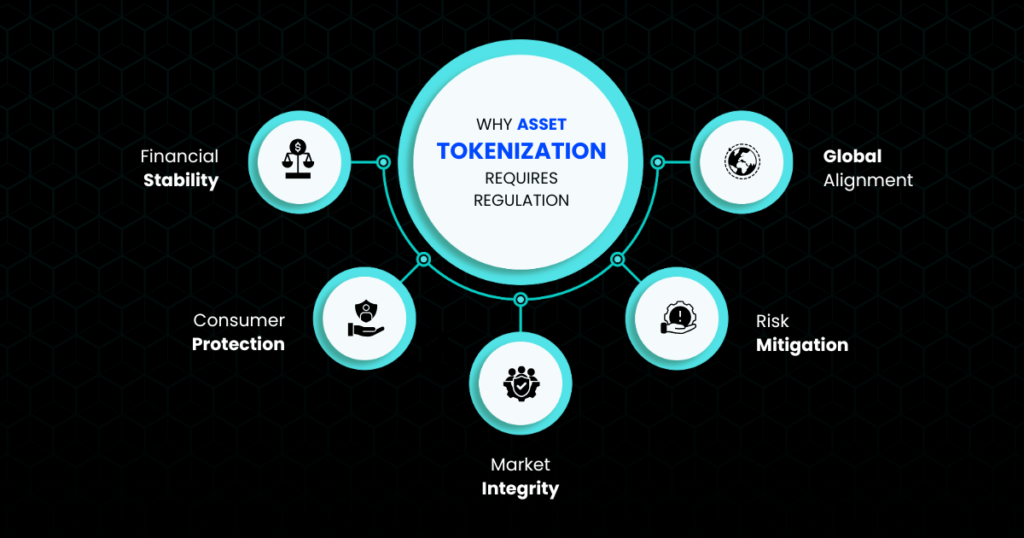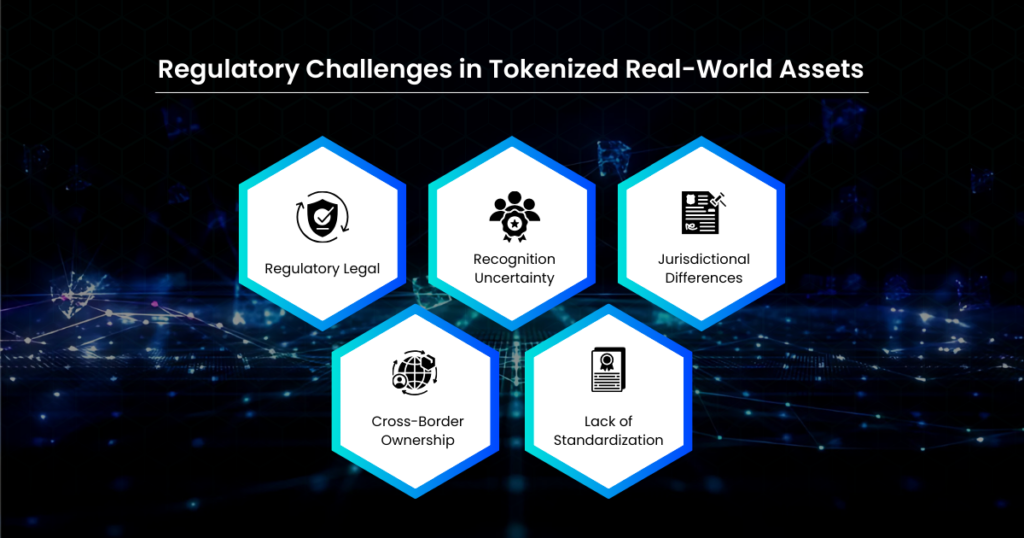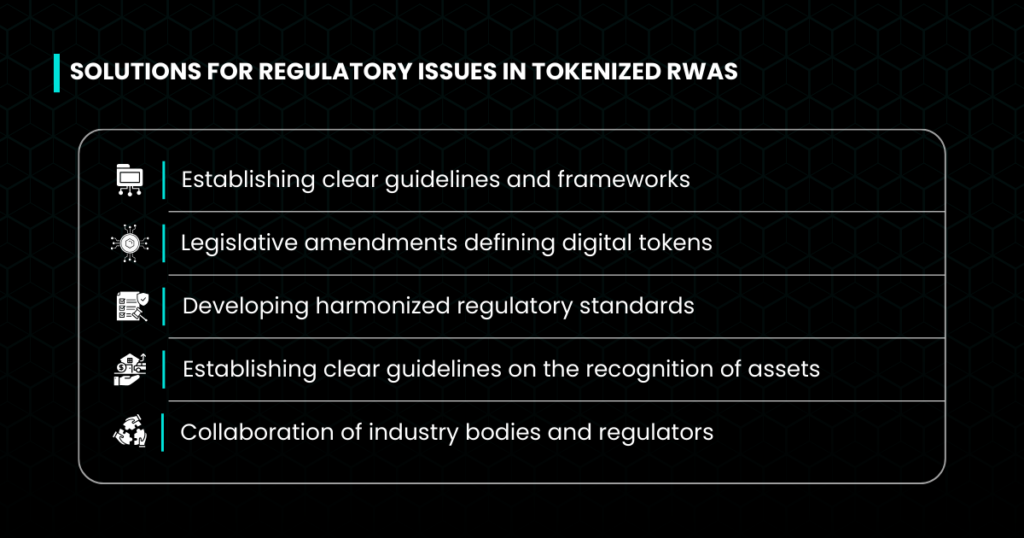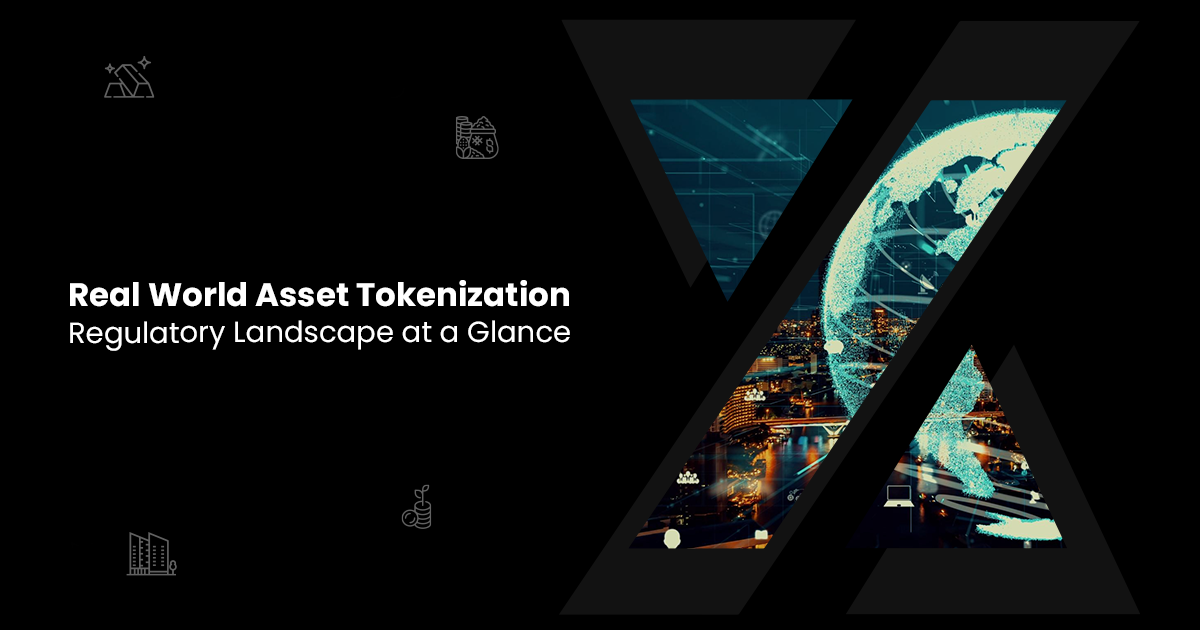Tokenized Asset Coalition, an industry group that now includes over 40 leaders in tokenization, promoting the tokenized assets market to reach new heights. Further, all these international bodies are working together in the direction of creating a standard set of rules and regulations. This step will promote enhanced market adoption of the tokenized assets and will smoothen the trading and investment journey in cross-border transactions. The collective efforts will enhance compliance across jurisdictions, aiding in the global integrity of rules and regulations.
All these reforming regulatory landscapes in the tokenized assets illustrate the elevating interest of the investors and giant institutions in the marketplace. Further, the legal framework for tokenization is crucial for the secure trading and investments of the tokenized assets, aiding the backing of the expansion of the tokenized assets. Throughout this blog post, we will understand the importance and need for asset tokenization compliance, the evolving domain of regulatory landscape around tokenized assets, countries framing the guidelines for the tokenized assets, importance, challenges, and solutions of regulatory compliance in tokenized real-world assets.
Key Takeaways:
- A comprehensive global review of the regulatory landscape for countries like the USA, Japan, Singapore, India, and the European Union.
- The importance of regulation in real-world asset tokenization, such as financial stability, consumer protection, market integrity, and risk mitigation.
- Regulatory challenges in tokenized real-world assets in the field of uncertain regulations, legal recognition, differences in jurisdictions, cross-border transactions, and lack of standardization.
- Overcoming regulatory barriers in the domain of tokenized real-world assets.
A Global View of the Regulatory Landscape Today
The regulatory landscape for tokenized real-world assets is evolving rapidly worldwide and hence, incorporating the emerging innovation for all the stakeholders. Through rising market value for the digital currency, the digital asset regulations are also maturing, further enveloping the tokenized real-world assets. Countries around the globe have their own set of regulatory guidelines to support the legal framework for tokenization and mitigate the risks associated with it. Here is a breakdown of the major key players around the globe and their regulations cantered around tokenized assets:
United States
The U.S. is currently the dominant leader with 34.8% of all tokenization initiatives, steered by the well-framed and solidified financial in the country. Further, the US has an independent agency named the Securities and Exchange Commission (SEC) for the regulations that govern the issuance and trading of tokenized assets, especially in the case of securities. Additionally, there are a few laws like the Securities Act of 1933 and the Howey Test that greatly impact the tokenization of real-world assets as well as trading and investments.
European Union
The European Union has a regulatory framework named MiCA (Markets in Crypto-Assets) Regulation that aims to create a structure for the assets. They provide regulatory clarity for trade and investments in multiple types of tokens. It works towards synchronizing the regulatory standards across the member states.
Moreover, the domain of tokenization in the European Union is extensively affected by the General Data Protection Regulation (GDPR). This works on handling personal data using blockchain technology.
Asia-Pacific
Japan is one of the key players in the tokenization of real-world assets and has established a regulatory structure for these assets as well as a digital currency.
Singapore is another major dominant force among the giants, encouraging trade and investments in tokenized assets. It has the Monetary Authority of Singapore (MAS) that implements a regulatory foundation for digital tokens under an act called the Payment Services Act. This architecture assures customer protection while promoting technological innovation in the financial sector.
India
India is one of the evolving countries stepping towards creating regulations for tokenized real-world assets. With major bodies like the Reserve Bank of India (RBI) and the Securities and Exchange Board of India (SEBI), making alignment towards supporting tokenization, India is witnessing a new wave of transactions. With promising projects like GIFT City as a hub for tokenization, India aims towards a more inclusive financial domain.

The Importance of Regulation in Asset Tokenization
Financial Stability
Regulatory compliance is significant for the financial stability of tokenized assets. As there are several stakeholders involved in the process of trading and investing in these assets, they will require legal protection for smooth functioning and a trustful environment for the stakeholders involved.
Consumer Protection
Regulatory compliance in the tokenized assets offers the investors, consumers, and sponsors a secure environment, protecting them from potential fraud. This ensures proper trade in the tokenized assets and maintains transparency and security.
Market Integrity
Asset tokenization compliance encourages trade and investments in several assets, promoting market integrity. This ensures all the participants participate equally and prevents market manipulation. This also makes the stakeholders adhere to the established rules and standards.
Risk Mitigation
The regulatory landscape in a few tokenized assets is crucial to mitigate the high market volatility, protecting the investors and other participants. This offers diligent oversight, and monitoring will ensure stakeholders participate in a secure, transparent, and user-friendly environment.
Global Alignment
Real World Asset Tokenization is an emerging domain, and hence the Regulatory Landscape around it should be evolving in nature. This helps in the global coordination of the rules and regulations and resonates with the diverse jurisdictions.

Regulatory Concerns in Tokenizing Real-World Assets
Regulatory Uncertainty
The ground of tokenization and the investment and trading in the tokenized real-world assets is still evolving. Henceforth, the regulations around them also keep evolving and often altering, creating complexities for issuers and investors. This generates vagueness in the minds of stakeholders, further deterring adoption.
Legal Recognition
In several parts of the world, tokenized assets are not legally recognized, drifting investors farther away from adopting them. A lack of legal recognition will not help investors or sponsors recognize the tokenized assets equivalent to their real-world counterparts.
Jurisdictional Differences
Regulatory challenges in tokenization also arise due to differences in jurisdiction. Certain regulations also depend on the type of tokenized assets and are highly affected by the rules of a particular company. This further adds hurdles in the path of adoption for businesses and institutions.
Cross-Border Ownership
Many countries have their own set of rules and regulations for the trade and investments in tokenized assets, to suit their needs and requirements. This cultivates another obstacle in the market adoption of tokenized assets at the global level.
Lack of Standardization
Due to the progressing nature of this domain, there is a lack of regulatory coordination as countries have rules as per their specifications and demands. This impedes global alignment on the tokenized real-world assets.

Overcoming Regulatory Barriers in Tokenized Real-World Assets
Creating and establishing clear regulatory guidelines for the tokenized assets will help both the institutions and investors to engage in a transparent process. This approach will increase the participation of the stakeholders in a conducive environment.
It is evident that the paradigm of tokenization is evolving and there are several new emerging assets joining the club of tokenization. However, well-defined legislative amendments can define RWA tokens, facilitating smoother transactions and ownership and protecting stakeholders’ rights on these assets.
Aligning with international bodies and institutions, countries can collaborate and harmonize the rules and standards for tokenized assets. This will reduce the hurdles and will increase efficiency in business operations across multiple jurisdictions.
Regulation in cross-border ownership and transactions demands clear guidelines on ownership rights. Further, developing a unified approach to taxation, dispute resolution, and enforcement of ownership rights across borders. Countries leading in trade and investments should collaborate and create a market-inclusive environment, aiding smaller and developing countries to participate.
Lack of standardization in the tokenization process necessitates the industry giants and regulators to collaborate and align the best practices. This also includes creating technical standards matching not just the needs of the regulatory institutions but also market requirements. Constructing a cluster of universally accepted guidelines to ensure consistency in how tokens are issued, traded, and managed.

As tokenization in real-world assets is gaining momentum in the market; several platforms allow their trading and investment. One such platform is STOEX.
STOEX is backed by KALP Distributed Ledger Technology (DLT) and strictly adhered to regulatory compliance, ensuring transparency and liquidity. With its structured approach, stringent security, and commitment to compliance, the platform offers an appealing option for diversified and efficient investing. Its regulation, security measures, focus on usability and customer-centric approach make it stand out as an accessible way of trading tokenized real-world assets.
Additionally, STOEX’s vision is to build a ground with reduced entry barriers and encourage a safe ecosystem for every individual interested in investing in the market. It pulls the strings of financial democratization by bridging the gap between investors and high-worth tokenized RWAs.
Concluding Remarks
The continuous rise in the adoption of tokenized assets and the framing of the rules and regulations around them demonstrates its growing importance. The regulatory landscape for these assets ensures security, transparency, and compliance for not just investors but also all the stakeholders involved. Further countries like the US, Japan, India, and others are continuously designing laws to increase participation in tokenized assets. There are several challenges such as regulatory uncertainty, jurisdictional differences, and the lack of standardization, international cooperation, and clearer guidelines will help unlock the full potential of tokenization.
As these concepts are still evolving, various platforms are adding to the layer of opportunities and options within these domains. One such option is STOEX, which allows investors to access the marketplace and trade effortlessly.
FAQs:
What is real-world asset tokenization, and how does it work?
Real-world asset tokenization involves converting physical assets into digital tokens on a blockchain. This process allows fractional ownership, easier transfer, and greater liquidity, enabling broader access to high-value investments.
What are the main regulatory challenges of asset tokenization?
The main regulatory challenges of asset tokenization include securities classification, anti-money laundering (AML), and cross-border jurisdiction challenges.
How does the regulatory landscape affect tokenized assets?
Regulations ensure security, compliance, and market integrity for tokenized assets, protecting investors and promoting cross-border adoption while mitigating risks.
Which countries have regulations for tokenized assets?
Countries like the U.S., EU, Japan, Singapore, and India have established frameworks to regulate the tokenization of real-world assets, though guidelines vary by jurisdiction.
Why is regulatory compliance important in tokenization?
Regulatory compliance ensures financial stability, consumer protection, and market integrity, fostering trust and enabling secure investments in tokenized assets.


